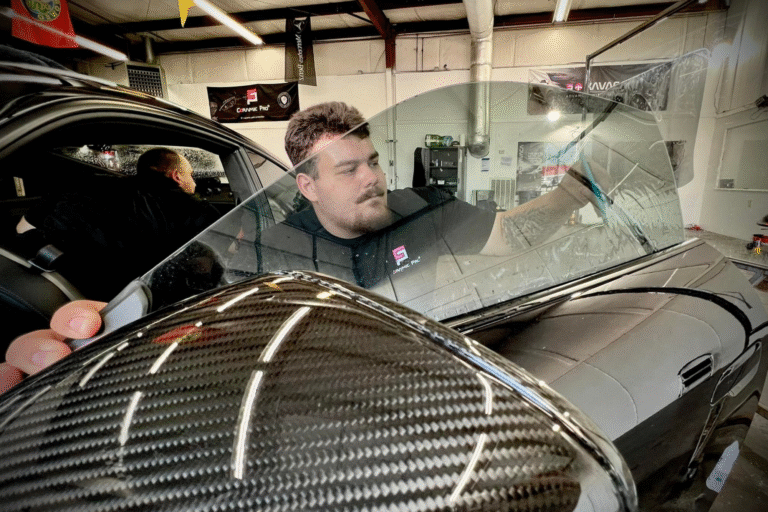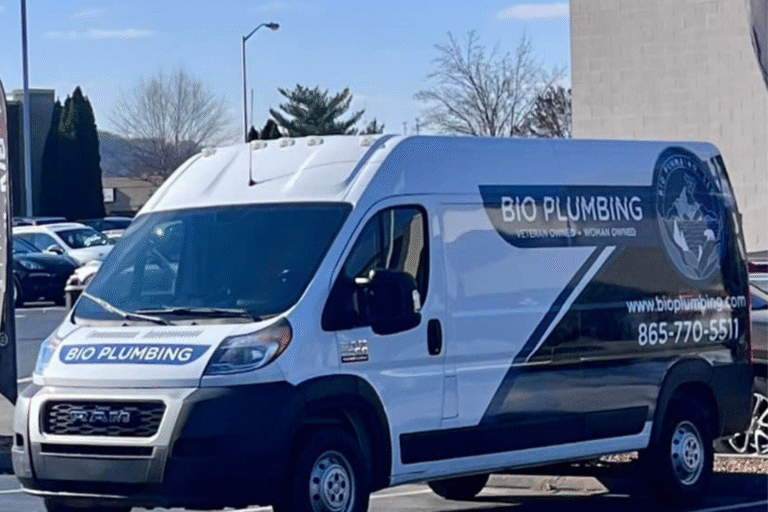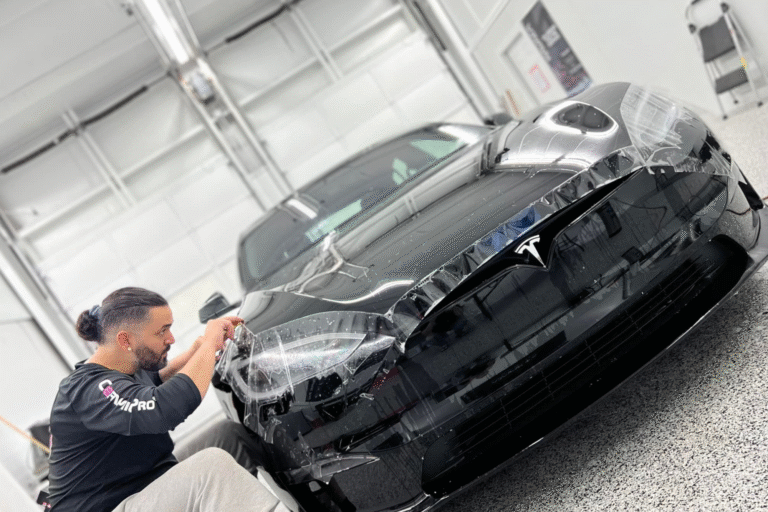When preparing your vehicle for ceramic coating in Knoxville, TN, each step plays an essential role in achieving a flawless finish that lasts. From the initial wash to the meticulous application process, attention to detail is critical in this transformative journey for your vehicle’s exterior. Remember, proper preparation sets the foundation for a ceramic coating that protects and enhances your car’s overall aesthetic appeal.
Key Takeaways
- Thoroughly wash, decontaminate, and correct paint imperfections.
- Inspect for flaws, mask off areas, and choose the suitable ceramic coating.
- Apply coating meticulously, allowing proper curing time.
- Conduct a final inspection for uniformity and smoothness.
- Enjoy enhanced durability, gloss, and reduced maintenance post-coating.
Vehicle Wash
Before applying a ceramic coating to your vehicle, it’s vital to thoroughly wash it to verify a clean surface for maximum adhesion. Choosing the right wash type and technique is essential when preparing your car for ceramic coating in Knoxville, TN.
Start by rinsing the vehicle with water to remove loose dirt and debris. Use a pH-neutral car wash soap to hand wash the vehicle, ensuring thorough coverage and gentle cleaning. Employ a microfiber wash mitt to prevent scratching the surface, moving in straight lines to avoid swirl marks.
For more stubborn dirt or grime, consider using a two-bucket wash method. Fill one bucket with soapy water and another with clean water to rinse your wash mitt and prevent contamination. This technique helps maintain the cleanliness of the wash solution, reducing the risk of reintroducing dirt to the vehicle’s surface.
Pay special attention to areas like the lower panels, wheels, and undercarriage, as they accumulate more dirt.
After washing, rinse the vehicle thoroughly to remove all soap residue. Consider using a detailing clay bar to remove contaminants bonded to the paint. This step guarantees a smooth surface that is ready for the ceramic coating application.
Surface Decontamination
Thorough surface decontamination is essential to guarantee the ideal adhesion of the car ceramic coating to your vehicle’s surface. Proper surface preparation is the foundation for a flawless ceramic coating application, and decontamination methods are vital in removing any contaminants that could hinder the bonding process.
Start by thoroughly washing your vehicle using a high-quality car shampoo and a microfiber wash mitt to remove dirt and grime. Once the vehicle is clean, the next step is decontaminating the surface.
Clay bar treatment effectively removes bonded contaminants like industrial fallout, tar, and tree sap. Gently glide the clay bar over the surface to pick up these impurities, leaving the paint smooth and contaminant-free.
After clay barring, consider using an iron remover to dissolve iron particles embedded in the paint. This step is crucial for maintaining a smooth surface.
Follow up with a solvent-based cleaner to eliminate any remaining residues or oils.
Paint Correction
Begin the paint correction process by evaluating the condition of your vehicle’s paintwork. Paint correction is a vital step in the ceramic coating preparation process, as it involves restoring the paint’s finish to its best condition.
Address imperfections such as swirl marks and paint dullness to achieve a flawless surface for ceramic coating application.
Skilled polishing techniques are essential for effective paint restoration. Polishing helps remove surface imperfections by leveling out the paint surface. This process requires precision and expertise to ensure smooth and defects-free paintwork.
By using suitable polishing compounds and pads, you can enhance the clarity and gloss of the paint, preparing it for the ceramic coating to bond effectively.
Attention to detail during the paint correction process is important, as even minor imperfections can affect the final result of the ceramic coating.
Through meticulous polishing techniques, you can achieve a showroom-quality finish that will enhance the appearance of your vehicle and provide long-lasting protection.
Inspection
During the inspection phase, it’s essential to meticulously assess the current state of your vehicle’s paintwork before proceeding with the ceramic coating preparation process.
Start by thoroughly inspecting the paint condition using an inspection checklist to guarantee no imperfections are overlooked.
Begin by examining the entire surface of your vehicle under different lighting conditions to detect any swirl marks or fading.
Note any areas where the paint may be peeling or chipping. Pay close attention to the edges and corners where damages are commonly found.
Next, check for contaminants such as tar, sap, or water spots that could affect the ceramic coating’s adhesion.
These need to be correctly removed before proceeding with the coating application.
Inspect the cleanliness of the paint surface to ensure no wax, polish, or residue remains.
Any residue can interfere with the bonding process of the ceramic coating, leading to subpar results.
Masking
Precise masking is essential to guarantee surface protection before applying a ceramic coating to your vehicle.
Properly masking off areas not intended for coating will secure a clean and professional finish.
Attention to detail during this step will lead to a flawless and precise ceramic coating application.
Surface Protection
To guarantee a flawless ceramic coating application, meticulous surface protection through masking is imperative.
When preparing your vehicle for ceramic coating in Knoxville, TN, follow these steps for precise surface protection:
- Delicate Areas: Carefully mask off delicate areas such as rubber seals and plastic trims to prevent any unwanted coating buildup that could be hard to remove later.
- Windows and Mirrors: Use high-quality masking tape to cover windows and mirrors, ensuring they remain free of ceramic coating residue.
- Wheel Wells: Cover the wheel wells with masking tape to prevent overspray and ensure a clean finish on your vehicle’s undercarriage.
- Panel Edges: Pay close attention to masking off panel edges to create crisp lines and prevent excess coating from seeping into unwanted areas, enhancing the overall look of the ceramic coating.
Precision Application
Precision and attention to detail are paramount in the meticulous application of ceramic coating. Masking plays a significant role in achieving flawless results when it comes to precision application. Proper masking guarantees that the ceramic coating is applied only to the intended areas, preventing any accidental overspray or unwanted contact with surfaces that shouldn’t be coated.
Effective application techniques involve carefully masking off sections that don’t require ceramic coating, such as windows, rubber trim, and sensitive areas. This step requires patience and a steady hand to create clean, precise lines that delineate the coating boundaries accurately.
Additionally, product selection is essential for achieving superior results during the ceramic coating process. Choosing high-quality masking tapes and products designed specifically for automotive applications can significantly affect the final outcome.
These products are engineered to withstand the chemicals used in the coating process and provide clean lines without leaving residue behind.
Ceramic Coating Application
Understanding the ceramic coating application process is essential to guarantee a flawless finish.
This step-by-step guide will guide you through the precise techniques to achieve ideal results.
Discover the benefits of ceramic coating and how it can protect your vehicle’s exterior for years.
Application Process Overview
Meticulous attention to detail is essential to guarantee ideal results during the ceramic coating application process.
To guarantee a flawless finish on your vehicle, follow these steps:
- Surface Preparation: Thoroughly clean and decontaminate the vehicle’s surface to remove any dirt, grease, or residue that could interfere with the bonding process.
- Product Selection: Choose the appropriate ceramic coating product based on your vehicle’s needs and desired protection level.
- Application Techniques: Apply the ceramic coating using precise, overlapping motions to guarantee even coverage and maximum durability.
- Curing Time: Allow the coating to cure for the recommended period, typically 24-48 hours, before exposing the vehicle to water or other elements.
Benefits of Coating
Achieving a ceramic coating on your vehicle offers many benefits that enhance its appearance and protection. The durability advantages of ceramic coatings are unparalleled, providing a long-lasting shield against various environmental contaminants, UV rays, and minor scratches.
This protective layer keeps your vehicle looking pristine and reduces the need for frequent waxing or detailing, saving you time and effort in the long run.
Moreover, the aesthetic enhancement that ceramic coating brings is remarkable. The coating creates a deep, glossy finish that intensifies your vehicle’s color and shine, making it stand out on the road.
It helps maintain that showroom-quality look, ensuring your car retains its value over time. With ceramic coating, you can enjoy a sleek and polished appearance that exudes sophistication and class, giving you a sense of pride and belonging as you cruise around Knoxville, TN.
Curing Process
The final step in the ceramic coating application process is the curing phase. This critical stage guarantees that the coating bonds effectively to your vehicle’s surface, providing long-lasting protection.
Pay attention to the following key points to guarantee a successful curing process:
- Curing Time: Follow the manufacturer’s instructions regarding the recommended curing time. This duration can vary based on the specific type of ceramic coating used.
- Environmental Factors: To allow the coating to cure properly, choose a well-ventilated area with moderate temperatures. Avoid direct sunlight or extreme heat, as these can impact the curing process.
- Avoid Moisture: Keep your vehicle from water or rain during curing. Moisture can interfere with the bonding process and compromise the effectiveness of the ceramic coating.
- Patience is Key: Allow sufficient time for the coating to cure fully before exposing your vehicle to harsh conditions. Rushing this step can lead to subpar results and reduce the longevity of the ceramic coating.
Final Inspection
Ensuring a thorough and meticulous final inspection of your vehicle post-ceramic coating application is essential to confirm the quality and effectiveness of the coating’s bond. As you prepare for this critical step, it’s imperative to have a final checklist to guide you through the inspection process with precision and expertise.
Begin by examining the entire surface of your vehicle under proper lighting conditions. Look for imperfections, such as streaks, bubbles, or uneven application. Pay close attention to the edges and corners where issues may be more prevalent. Use a high-quality light source to illuminate each section thoroughly, ensuring no detail goes unnoticed.
One common mistake during the final inspection is rushing through the process. Take your time and inspect the vehicle methodically, panel by panel, to catch any inconsistencies that may compromise the ceramic coating’s integrity. Verify that the coating has dried uniformly and that there are no visible defects.
After completing the visual inspection, gently run your hands over the coated surface. Feel for smoothness and uniform texture to confirm a well-applied ceramic coating. Any rough spots or irregularities should be addressed promptly to maintain the coating’s effectiveness.
Maintenance Tips
Adhering to proper maintenance practices is critical to maintaining the pristine condition and longevity of your ceramic coating. Here are some expert tips to help you keep your vehicle looking its best for the long term:
- Regular Washes: Wash your vehicle every 2 weeks using a pH-neutral shampoo and a microfiber wash mitt to prevent scratching the ceramic coating.
- Avoid Abrasive Materials: To protect the coating’s integrity, avoid harsh chemicals, stiff brushes, or abrasive sponges during washing.
- Interior Detailing: Regularly clean and vacuum the interior to prevent dirt and debris from damaging the coating when brought in from the inside.
- Long-Term Care: Consider annual maintenance inspections by professionals to verify that the ceramic coating is performing at its best and to make any necessary touch-ups.
To Sum Up
With precision and expertise, you’ve successfully prepped your vehicle for ceramic coating in Knoxville, TN. Your car is ready to shine and turn heads on the road. Remember, maintaining this level of perfection requires dedication and attention to detail. So, don’t forget to follow our maintenance tips to guarantee your ceramic coating lasts longer than you ever imagined. Happy driving! For top-tier ceramic coating services, trust Ceramic Pro Knoxville to provide exceptional care and lasting protection for your vehicle






